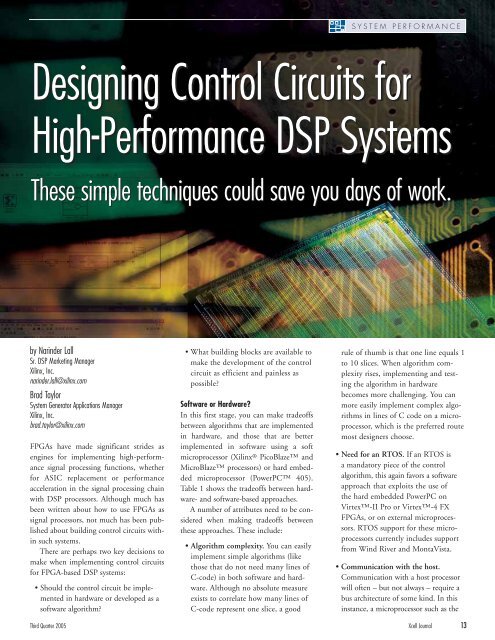Design Challenges: Avoiding the Pitfalls, winning the game - Xilinx
Design Challenges: Avoiding the Pitfalls, winning the game - Xilinx
Design Challenges: Avoiding the Pitfalls, winning the game - Xilinx
Create successful ePaper yourself
Turn your PDF publications into a flip-book with our unique Google optimized e-Paper software.
<strong>Design</strong>ing Control Circuits for<br />
High-Performance DSP Systems<br />
by Narinder Lall<br />
Sr. DSP Marketing Manager<br />
<strong>Xilinx</strong>, Inc.<br />
narinder.lall@xilinx.com<br />
Brad Taylor<br />
System Generator Applications Manager<br />
<strong>Xilinx</strong>, Inc.<br />
brad.taylor@xilinx.com<br />
FPGAs have made significant strides as<br />
engines for implementing high-performance<br />
signal processing functions, whe<strong>the</strong>r<br />
for ASIC replacement or performance<br />
acceleration in <strong>the</strong> signal processing chain<br />
with DSP processors. Although much has<br />
been written about how to use FPGAs as<br />
signal processors, not much has been published<br />
about building control circuits within<br />
such systems.<br />
There are perhaps two key decisions to<br />
make when implementing control circuits<br />
for FPGA-based DSP systems:<br />
• Should <strong>the</strong> control circuit be implemented<br />
in hardware or developed as a<br />
software algorithm?<br />
• What building blocks are available to<br />
make <strong>the</strong> development of <strong>the</strong> control<br />
circuit as efficient and painless as<br />
possible?<br />
Software or Hardware?<br />
In this first stage, you can make tradeoffs<br />
between algorithms that are implemented<br />
in hardware, and those that are better<br />
implemented in software using a soft<br />
microprocessor (<strong>Xilinx</strong> ® PicoBlaze and<br />
MicroBlaze processors) or hard embedded<br />
microprocessor (PowerPC 405).<br />
Table 1 shows <strong>the</strong> tradeoffs between hardware-<br />
and software-based approaches.<br />
A number of attributes need to be considered<br />
when making tradeoffs between<br />
<strong>the</strong>se approaches. These include:<br />
• Algorithm complexity. You can easily<br />
implement simple algorithms (like<br />
those that do not need many lines of<br />
C-code) in both software and hardware.<br />
Although no absolute measure<br />
exists to correlate how many lines of<br />
C-code represent one slice, a good<br />
SYSTEM PERFORMANCE<br />
These simple techniques could save you days of work.<br />
rule of thumb is that one line equals 1<br />
to 10 slices. When algorithm complexity<br />
rises, implementing and testing<br />
<strong>the</strong> algorithm in hardware<br />
becomes more challenging. You can<br />
more easily implement complex algorithms<br />
in lines of C code on a microprocessor,<br />
which is <strong>the</strong> preferred route<br />
most designers choose.<br />
• Need for an RTOS. If an RTOS is<br />
a mandatory piece of <strong>the</strong> control<br />
algorithm, this again favors a software<br />
approach that exploits <strong>the</strong> use of<br />
<strong>the</strong> hard embedded PowerPC on<br />
Virtex-II Pro or Virtex-4 FX<br />
FPGAs, or on external microprocessors.<br />
RTOS support for <strong>the</strong>se microprocessors<br />
currently includes support<br />
from Wind River and MontaVista.<br />
• Communication with <strong>the</strong> host.<br />
Communication with a host processor<br />
will often – but not always – require a<br />
bus architecture of some kind. In this<br />
instance, a microprocessor such as <strong>the</strong><br />
Third Quarter 2005 Xcell Journal 13

















